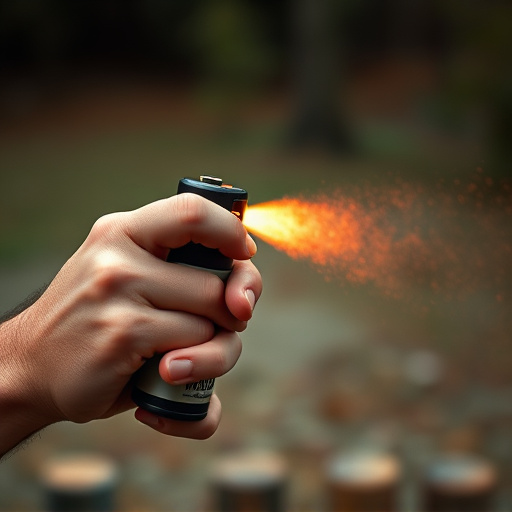Pepper spray, a common riot control agent, disables individuals through capsaicin from chili peppers, causing eye irritation, respiratory distress, and temporary blindness. Its effects last between 20 to 60 minutes, with severe reactions persisting longer. Proper protective gear, ventilation, and post-exposure care are essential to mitigate discomfort and speed recovery, answering the key question: How long do pepper spray effects last?
Riot control inflammatory spray, also known as pepper spray, is a powerful tool used by law enforcement and self-defense enthusiasts alike. This article delves into the intricate world of these canisters, exploring their composition, effectiveness, and long-lasting effects. We’ll uncover the science behind pepper spray’s impact on the human body, dissecting its duration and potential outcomes. Additionally, we provide essential safety precautions and post-exposure care guidance to ensure awareness and preparation for those caught in its path, focusing specifically on understanding how long pepper spray effects last.
- Understanding Riot Control Spray: Composition and Purpose
- The Science Behind Pepper Spray's Effectiveness
- Duration of Effects: What to Expect and Prepare For
- Safety Precautions and Post-Exposure Care
Understanding Riot Control Spray: Composition and Purpose
Riot control spray, also known as pepper spray, is a powerful tool used to disrupt and disperse crowds during civil unrest or large gatherings. Its primary purpose is to temporarily incapacitate individuals, providing law enforcement agencies with time to restore order. This spray is designed to cause irritation and pain in the eyes, nose, and respiratory system, leading to temporary blindness and difficulty breathing.
The composition of riot control spray includes capsaicin, a chemical derived from chili peppers, which is the active ingredient causing the intense irritation. When deployed, the canisters emit a fine mist that quickly spreads, ensuring widespread coverage. The effect of pepper spray lasts for a variable period, typically ranging from 15 minutes to an hour, depending on the concentration and individual sensitivity. This duration allows those affected to become non-threatening, enabling authorities to control the situation effectively.
The Science Behind Pepper Spray's Effectiveness
Pepper spray, a common riot control agent, works by disrupting the normal functioning of the eyes and respiratory system. It contains capsaicin, the same compound that gives chili peppers their heat. When sprayed, capsaicin comes into contact with nerve endings, triggering a response that leads to temporary blindness, intense pain, and difficulty breathing. This overwhelming sensation helps to disable and disperse rioters or aggressors quickly.
The effectiveness of pepper spray is measured in part by how long its effects last. Typically, the numbing effect can last for around 30 minutes, while breathing difficulties may persist for up to an hour. These timeframes vary based on factors like the concentration of capsaicin, weather conditions, and individual sensitivity. Understanding these durations is crucial for both law enforcement and individuals seeking protection, as it helps determine the appropriate use and deployment strategies for riot control inflammatory spray canisters.
Duration of Effects: What to Expect and Prepare For
The duration of effects from a riot control inflammatory spray canister, often referred to as pepper spray, can vary significantly based on several factors. On average, the effects typically last between 20 minutes and an hour. During this time, individuals sprayed may experience irritation and discomfort in their eyes, breathing difficulties, and temporary numbness or pain in affected areas. It’s crucial to prepare for these potential outcomes by ensuring you have protective gear, such as goggles and a face mask, readily available.
Understanding the transient nature of pepper spray’s effects is essential for both those who carry it for self-defense and law enforcement agencies using it for crowd control. Knowing what to expect allows users to remain vigilant and seek immediate medical attention if needed after the spray wears off, as some individuals may experience lingering symptoms or adverse reactions.
Safety Precautions and Post-Exposure Care
When handling and using riot control inflammatory spray canisters, safety precautions are paramount. Pepper spray, also known as oleoresin capsicum (OC) spray, can cause severe irritation and temporary incapacitation. Always wear protective gear, including goggles to shield your eyes from splashing chemicals, and gloves to prevent skin contact. Ensure adequate ventilation in the area to minimize inhalation of spray particles. Keep a safe distance from individuals who may be affected, as pepper spray effects can last for several minutes, causing difficulty breathing, coughing, and pain.
Post-exposure care is crucial after using or being exposed to pepper spray. If your eyes become irritated, rinse them gently with clean water for at least 15 minutes. Remove any contaminated clothing and wash the affected area with mild soap and water. Seek medical attention if symptoms persist or worsen. It’s important to note that how long pepper spray effects last can vary; however, most individuals experience sensitivity and discomfort for around 20-60 minutes, while more severe reactions may last longer. Proper post-exposure care helps alleviate these symptoms and promotes faster recovery.
Riot control inflammatory spray, or pepper spray, is a powerful tool designed for specific emergency situations. Understanding its composition, effectiveness, and safety aspects is crucial when considering its use. The duration of effects varies but can last from several minutes to an hour, depending on the formula and individual factors. It’s essential to be prepared for these temporary but intense disabilities and have a plan for post-exposure care. Always follow safety precautions to minimize risks and ensure that any use of pepper spray is justified and proportionate.
